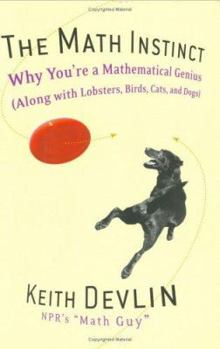The Math Instinct: Why You're a Mathematical Genius (Along with Lobsters, Birds, Cats, and Dogs)
Select Format
Select Condition 
Book Overview
There are two kinds of math: the hard kind and the easy kind. The easy kind, practiced by ants, shrimp, Welsh corgis -- and us -- is innate. What innate calculating skills do we humans have? Leaving... This description may be from another edition of this product.
Format:Hardcover
Language:English
ISBN:1560256729
ISBN13:9781560256724
Release Date:March 2005
Publisher:Thunder's Mouth Press
Length:279 Pages
Weight:1.05 lbs.
Dimensions:1.1" x 5.9" x 8.6"
Customer Reviews
3 ratings
Has its faults, but a lot of interesting material
Published by Thriftbooks.com User , 17 years ago
"The Math Instinct" is something of a hodge-podge, and I think it could be written better, but there is lots of really interesting material, and the reader can always skip chapters not of interest to him/her. I say the book isn't written that well, because Devlin doesn't do well enough with the more difficult concepts. I say it is a hodge podge because subjects such as the nautilus's shell have nothing to do with the rest of the book; in fact Devlin waits far too long to distinguish between computational skills of animals, such as their navigational skills, and the results of optimization through evolutionary trial and error (bee's hexagonal honeycomb) which has nothing to do with the animal brain's capacity for doing math. Amazingly, a numerical sense has been found to exist in baby's only a few days old, as well as in rats, etc. Brazilian children who could not master arithmetic in school, do great when they need to employ math in the marketplace. When math is abstract and rule based, without making sense, it is hard to learn or apply. It actually uses a part of the brain devoted to language rather than a part used for "natural" math (which incidentally grew out of the area used to control digits). Devlin addresses teaching math, but surprisingly doesn't have much too say, emphasizing repetitive practice rather than a change in presentation. For example, for reasons Devlin gives, learning 7 x 8 = 56 is particularly hard, so why not teach 7 x 8 = 7 x 7 + 7, thereby giving the idea of multiplication as a quick way to do some kinds of addition, and taking advantage of the kind of techniques untutored Brazilian working kids use in the marketplace?
Animal Instinct and Human Psychology
Published by Thriftbooks.com User , 17 years ago
Although the word "math" appears in the title, this book is mainly about instinct and psychology. About half the book contains discussions on how animals instinctively do certain things that have some foundation in math. The other half of the book looks at how humans perceive and behave in math-related situations - from infancy to adulthood. The book is very well-written, very clear and easy to read. Those who are math phobic have nothing to fear here; in fact, they would likely find this book very interesting in the sense that they would learn something fascinating about themselves. Other than for those who are math phobic, this book has something for psychology buffs as well as animal lovers. But most importantly, it should grace the shelves of math educators as well as those who are interested in the reasons and possible cures for innumeracy.
Intriguing Accounts of Animal and Street Math
Published by Thriftbooks.com User , 18 years ago
This book offers a very readable overview for the non-specialist, with many fascinating details on how animals use their kinds of natural mathematics. It also discusses the findings of Brazilian researchers on how teenage street vendors who can't handle school math develop their own effective street math techniques. The author makes abundantly clear that many people can't deal with school math because it is presented as an abstract symbolic system. People can learn best, he argues, by applying math in concrete ways. Unfortunately, he stops short at the end of the book and simply enjoins us to practice because that is the way humans gain mastery over subjects. It would have been useful for him to spell out how such practice can best be done and to give examples. I recall an awful pre-calculus course that spent a full year trying to prove a set of theorems, leaving us students with no knowledge of how to apply calculus to scientific, financial, or other problems (this was the last exposure to math for most of the class). We would have learned much better by applying calculus to real problems, then perhaps concluding the year with a bit of theory. I recommend this book to readers who enjoy popular science literature or want to know more about animal math.





